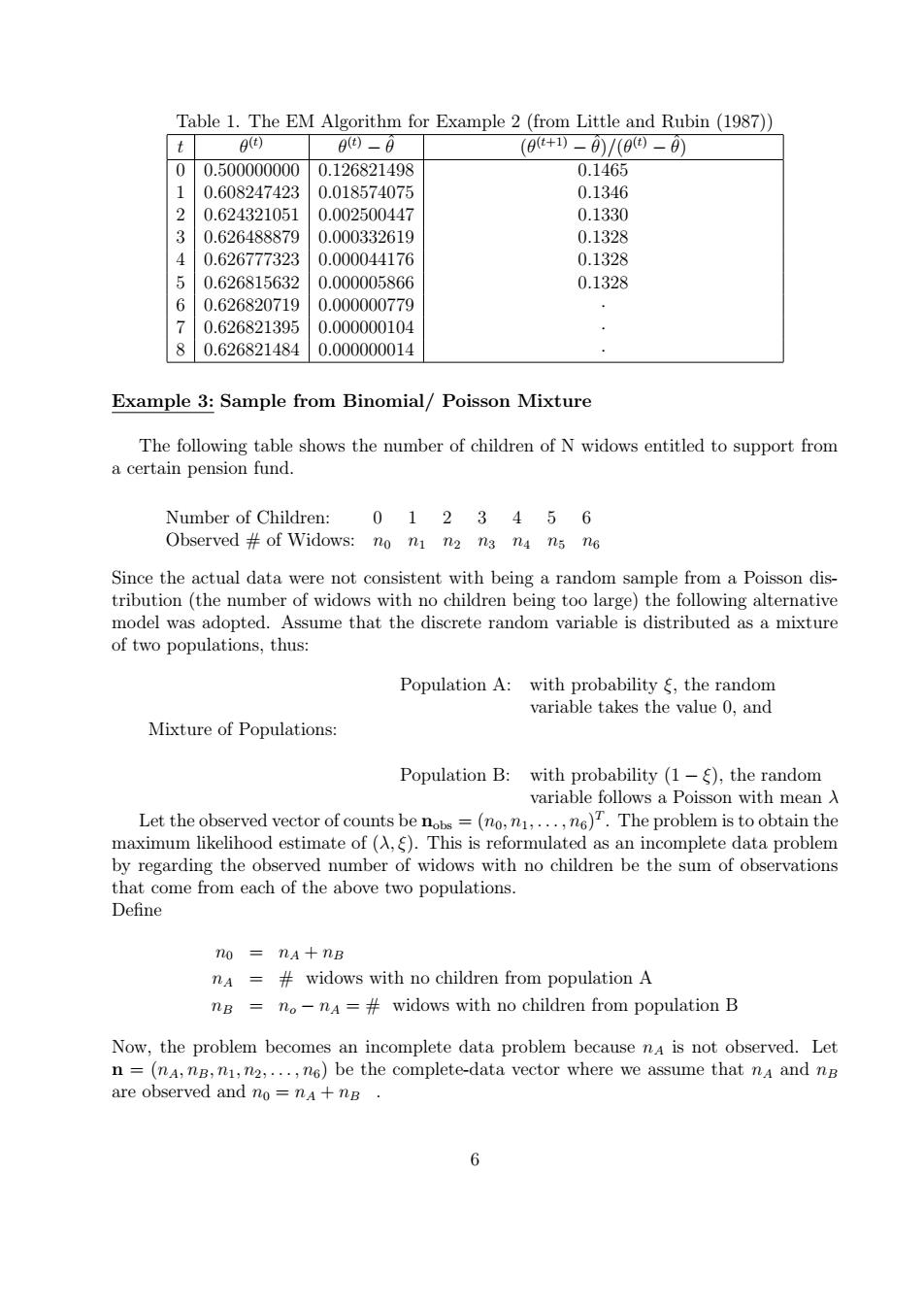正在加载图片...

Table 1.The EM Algorithm for Example 2 (from Little and Rubin (1987)) t 00) 0©-8 (0+-)/(0©-0) 00.500000000 0.126821498 0.1465 1 0.608247423 0.018574075 0.1346 2 0.624321051 0.002500447 0.1330 3 0.626488879 0.000332619 0.1328 4 0.626777323 0.000044176 0.1328 5 0.626815632 0.000005866 0.1328 6 0.626820719 0.000000779 7 0.626821395 0.000000104 0.626821484 0.000000014 Example 3:Sample from Binomial/Poisson Mixture The following table shows the number of children of N widows entitled to support from a certain pension fund. Number of Children:0 1 2 3 4 5 6 Observed of Widows:no n1 n2 n3 n4 n5 n6 Since the actual data were not consistent with being a random sample from a Poisson dis- tribution (the number of widows with no children being too large)the following alternative model was adopted.Assume that the discrete random variable is distributed as a mixture of two populations,thus: Population A:with probability &the random variable takes the value 0,and Mixture of Populations: Population B:with probability (1-E),the random variable follows a Poisson with mean A Let the observed vector of counts be nobs =(no,n,...,n6)T.The problem is to obtain the maximum likelihood estimate of (A,)This is reformulated as an incomplete data problem by regarding the observed number of widows with no children be the sum of observations that come from each of the above two populations. Define no nA+nB nA =widows with no children from population A nB no-nA =widows with no children from population B Now,the problem becomes an incomplete data problem because na is not observed.Let n=(nA,nB,n1,n2,...,n6)be the complete-data vector where we assume that na and nB are observed and no nA+nB. 6Table 1. The EM Algorithm for Example 2 (from Little and Rubin (1987)) t θ (t) θ (t) − ˆθ (θ (t+1) − ˆθ)/(θ (t) − ˆθ) 0 0.500000000 0.126821498 0.1465 1 0.608247423 0.018574075 0.1346 2 0.624321051 0.002500447 0.1330 3 0.626488879 0.000332619 0.1328 4 0.626777323 0.000044176 0.1328 5 0.626815632 0.000005866 0.1328 6 0.626820719 0.000000779 · 7 0.626821395 0.000000104 · 8 0.626821484 0.000000014 · Example 3: Sample from Binomial/ Poisson Mixture The following table shows the number of children of N widows entitled to support from a certain pension fund. Number of Children: 0 1 2 3 4 5 6 Observed # of Widows: n0 n1 n2 n3 n4 n5 n6 Since the actual data were not consistent with being a random sample from a Poisson distribution (the number of widows with no children being too large) the following alternative model was adopted. Assume that the discrete random variable is distributed as a mixture of two populations, thus: Population A: with probability ξ, the random variable takes the value 0, and Mixture of Populations: Population B: with probability (1 − ξ), the random variable follows a Poisson with mean λ Let the observed vector of counts be nobs = (n0, n1, . . . , n6) T . The problem is to obtain the maximum likelihood estimate of (λ, ξ). This is reformulated as an incomplete data problem by regarding the observed number of widows with no children be the sum of observations that come from each of the above two populations. Define n0 = nA + nB nA = # widows with no children from population A nB = no − nA = # widows with no children from population B Now, the problem becomes an incomplete data problem because nA is not observed. Let n = (nA, nB, n1, n2, . . . , n6) be the complete-data vector where we assume that nA and nB are observed and n0 = nA + nB . 6